↑ ↓ ↑ ↓
RONALD L. BLOORE
NOT WITHOUT DESIGN
by Terrence Heath
Chapter Two
THE NORMAN MACKENZIE ART GALLERY
AND THE REGINA FIVE
1958-1966
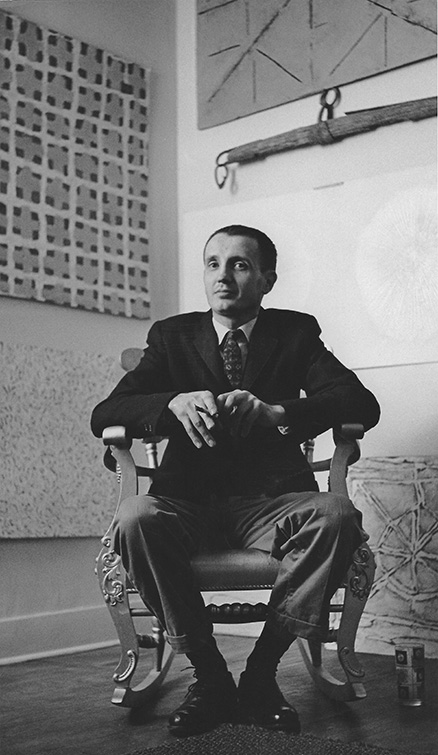
←CH.1 CH.3→ CH.4→
↑ ↓ ↑ ↓
In 1958, Ron Bloore was offered the position of Director/Curator of the new university gallery in Regina, Saskatchewan. He says he accepted it because it paid $500 a year more than what he could make teaching at the University of Toronto. Whatever the reason, the decision to accept the job marked a major turning point in his life. It catapulted him from an art history atmosphere into the contemporary world of making and exhibiting art.
Not that he wasn't painting in Toronto. It was while he was still at the University of Toronto that he began using stove enamel on masonite in all-over abstract compositions. He also did his first work in white on white during the 1957-58 academic year. But the University was focused on art history; the practice of art was left to the Ontario College of Art.
↑ ↓ ↑ ↓
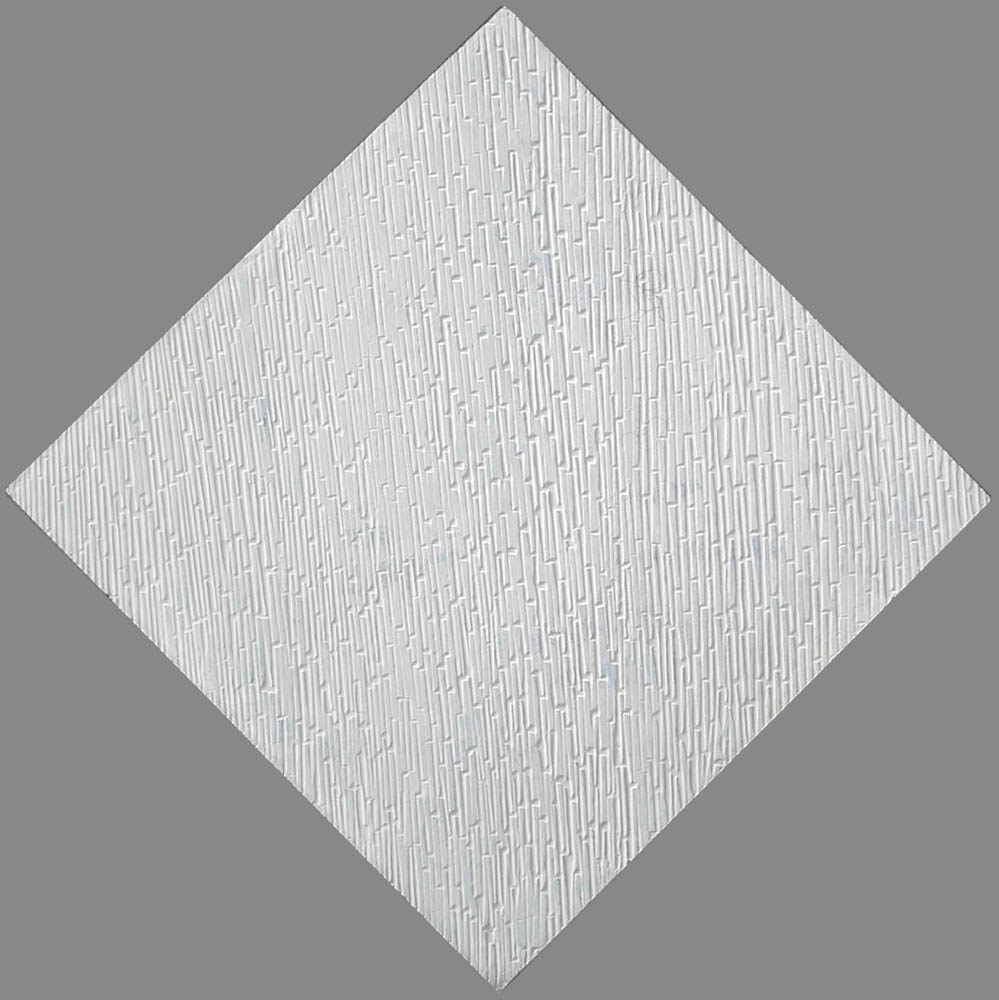
1958, Untitled, Catalog No.1, 172x172cm, stovepipe enamel on masonite
And, not that he didn't teach in Regina. Among his many duties was instruction in art history and archaeology at Regina College (to become the University of Saskatchewan, Regina Campus in 1961, and the University of Regina in 1974). The College taught mainly studio art, with art history taken as a supplementary course. Bloore took particular pleasure in the symbolism of the School of Art occupying the upper floor of the building with the Art Gallery occupying the ground and basement floors.
Bloore emerged almost immediately as one of the most dynamic art gallery directors in Canada. He took over the only gallery of any size or facilities in Western Canada apart from Vancouver. At the time, the Winnipeg Art Gallery was still located in the upper floor of the Courthouse. The gallery in Saskatoon was in the basement of a hotel. Calgary and Edmonton had similarly inadequate facilities. Regina boasted a new gallery, centrally located and designed by the staff of the National Gallery of Canada, with three large exhibition areas and two small ones.
The previous Director/Curator, Richard Simmins, had done a great deal to establish a regular exhibition schedule and lecture series and to insist on certain standards of quality for the new gallery. His move to the National Gallery in 1958 did not remove his continuing interest in and support for the Regina gallery.
And, finally, Ron Bloore stepped into a position where he could make decisions without having to report to anyone other than the Dean of the College, Dr. W.A. (Bill) Riddell. Both Bloore and Riddell were persons of strong opinions and they clashed continually over exhibitions and acquisitions. Later, Riddell was to write circumspectly of Bloore's "freewheeling flair," but the phrase conceals a rather more acerbic relationship.(1) Their differences of opinion, however, did not seem to restrict their accomplishing the most surprising things for the gallery. With Bloore forging ahead and Riddell supporting him publicly and "reading the Riot Act to him privately,"(2) they put the gallery on the national and international map.
Bloore hit the Regina art scene like one of the sudden storms the region is so famous for. Within a short period of time, he had examined the Gallery's legacy of art works donated by Norman Mackenzie and declared them falsely attributed to major European artists. He immediately started replacing the names of the masters with "Anonymous" or "School of." Friends of the late Norman Mackenzie and longtime supporters of the Gallery were incensed. Riddell was caught in the middle of the controversy, trying to placate the one side and mollify the other.
Then, Bloore cancelled the provincial juried art exhibition on the basis that the works were of inferior quality; artists of long standing in the province felt not only disregarded, but rejected.(3) He later recalled, "I banned all local exhibitions. I banned all provincial exhibitions."(4) He began to show contemporary artists from Central Canada - Molinari, Gaucher, Town, Curnoe. And these unpopular acts were accompanied by a constant series of highjinks, often involving the Director of the School of Art, Ken Lochhead, art instructor, Art McKay, local painter/businessman, Doug Morton, and, later, the young Calgary painter, Ted Godwin. Ken Lochhead was to remember their activities more kindly as the enthusiasms of "evangelists" with Bloore in the role of prophet, spouting "brimstone and fire."(5)
When the Acquisitions Committee of the Gallery (the only other hoop Bloore had to jump through) turned down the purchase of Greg Curnoe's Tall Girl When I am Sad on Dundas Street, Bloore took his cause to the public of Regina. With the full assistance of his colleagues and the students at the Art School, he mounted a campaign to raise the necessary monies. The painting became a local cause celebre and after extensive coverage, some good and a lot negative, the necessary funds were gathered and the committee bypassed. He won - but at a price. He came to be seen, even by friends, as dictatorial, insisting on having his own way in matters of art.(6)
↑ ↓ ↑ ↓
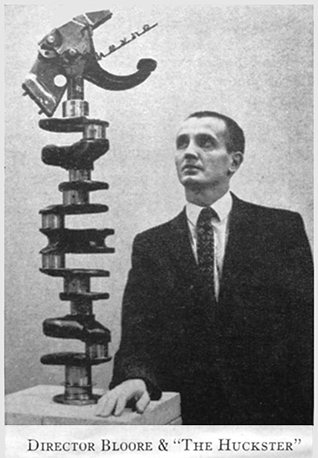
Win Hedore, Time Magazine, Nov.7, 1960
The act which earned him the most notoriety and, eventually, coverage in Time Magazine, as well as notice in newspapers from coast the coast, was the 1960 exhibition, Images and Studies, an exhibition by Win Hedore.(7) It was an exhibition cobbled together by God(win), Loch(he)a(d) and Blo(ore) out of junk - old car parts, a dented pail, bricks. bottles - and included in the regular exhibition schedule of the Gallery with no word of explanation. Some people were amused; many were outraged. And of course, Bloore's reputation preceded him.
The group, Lochhead, McKay, Godwin, Morton, Kiyooka and Bloore, saw themselves as harbingers of modern art. They espoused non-representation, experimentation, and innovation. They preached the word in the cause of modernity.(8) Their own work came together for the Canadian public in 1961 when the epithet "The Regina Five" came into use. (Roy Kiyooka had moved away in 1959). In 1960, Bloore mounted an exhibition of the work of Lochhead, McKay, Godwin, Morton and himself and of the Regina architect, Clifford Wiens, featuring it as The May Show. Richard Simmins picked it up, eliminated Wiens, and showed it at the National Gallery in 1961 as Five Painters from Regina. It was the making of an art historical category for Canada, but also led to the obscuring of how different the work and aspirations of each of these painters was.
Behind the fireworks, however, Bloore conscientiously built an exhibition schedule and acquired works for the permanent collection which gave substance and direction to the artists in the province. Bloore emphasized quality and diversity in his exhibition schedule, and in spite of his background in art history, focused on modern and contemporary work.(9) In 1960-61, for example, the Gallery featured exhibitions ranging through Harold Town, International Guggenheim Prize entries, Japanese Woodblock Prints and Ceramics, Electronic Communication, Maxwell Bates, Jan Wyers, the Canadian Group of Painters Exhibition, Art McKay, Recent British Sculpture and New Talent in the USA. His parting exhibition in 1966 was the controversial work of Edward Kienholz.(10)
In 1960, on Bloore's strong recommendation, the Gallery made what was to be its most important purchase, the sculpture Mother and Child II by Jacques Lipchitz. It cost $12,000, which was for the time and place an astronomical sum. Bloore actually wanted to buy the more expensive Figure, which was available for $18,000. With a recommendation from the National Gallery and the strong insistence of Bloore and Riddell, the Acquisitions Committee finally agreed to purchase it from funds which had been bequeathed to the Gallery.(11) Bloore also set to work to incorporate contemporary Canadian works into the collection. The Norman Mackenzie Art Gallery was the first public collection to own a Guido Molinari, and a Greg Curnoe. He bought works by Yves Gaucher, Alfred Pellan, Graham Coughtry, Jock Macdonald, Harold Town, and Tony Urquhart. And, he bolstered the historic collection with works by David Milne, Le Moine Fitzgerald, Lawren Harris and others.
In spite of the national and international range of these exhibitions and acquisitions, and in spite of his decision to discontinue the annual juried exhibitions, Bloore, nevertheless, saw his role of Director/Curator as a catalyst for the local artists; or, at least, for those that he judged to be worth being a catalyst for. His exhibitions and his support to his fellow artists were among the most lasting of their memories. Morton judges him to have been influential, not as a theorist or as a personality, but as an organizer of exhibitions and as a fellow artist.(12) Lochhead emphasizes the impact of his exhibitions and sums up Bloore's curatorial abilities in the statement: "He has a visual mind."(13) Viewing developments from a distance, Richard Simmins could say: "Bloore acted as a catalyst. He brought with him an inflexible, uncompromising set of values - a bit puritanical - which provided a challenge to the other artists."(14) Bloore's credo as a gallery director was "that a curator should function with some artists that lived in the community."(15) His support of certain local artists can be seen in his purchases: In 1965, he listed the works by Saskatchewan artists he had brought into the collection. Included in the list are works by Roy Kiyooka, Art McKay, Ted Godwin, Doug Morton and Ernest Lindner.(16)
It then comes as something of a surprise when, much later, Ron Bloore was asked what he had accomplished in Regina during the eight years he was Director of the Norman Mackenzie Art Gallery and he answered succinctly: "The only thing I did in Saskatchewan was I followed in the footsteps of Norah McCullough and gave recognition to Jan Wyers; that is the only thing I accomplished in Saskatchewan."(17) Bloore has a habit of making statements which sound exaggerated and seem aggressively to invite a challenge. I have found, however, that such statements have been thought through, their succinctness and provocative formulation hiding a well-founded judgement. The judgement involved here is basic to Bloore's very definition of art itself.
↑ ↓ ↑ ↓
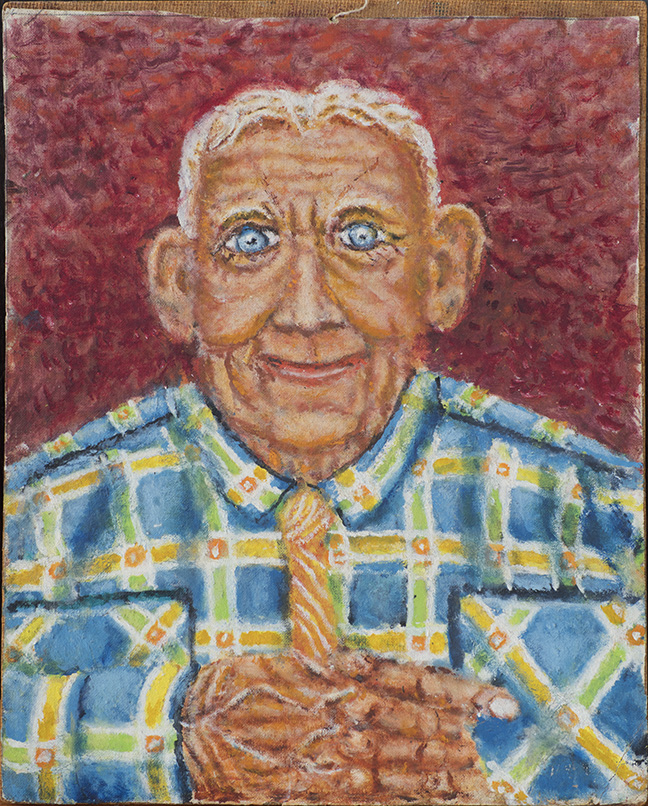
Jan Wyers, Self Portrait, 1960, oil on canvas on masonite, 40x35cm
Jan Wyers has become one of the folk heroes of the Canadian art world.(18) His brightly painted canvases are in public and private collections across Canada. Wyers was an unschooled painter, coming from Holland in 1916 to farm near the small village of Windhorst, located about 135 kilometers east southeast of Regina. He painted local farm scenes, remembered childhood places, pets, people, self portraits, whatever came into his head or arrived in the mail. He painted in bright, impressionistic colours with a strong sense of image. Bloore calls one of his works, These Good Old Thrashing Days, "...one of the few major iconic visions in the art of Canada or of the Great Plains."(19) As Bloore is at pains to point out, he did not "discover" Wyers. Norah McCullough, at the time a liaison officer of the National Gallery of Canada, brought Wyers to the attention of Bloore; Art McKay and Roy Kiyooka first showed Bloore These Good Old Thrashing Days shortly after his arrival in Regina.(20) Bloore purchased and exhibited Wyers' work. And, he has continued to champion him as a major Canadian painter.
Bloore's interest in Wyers is part of a much larger interest in the nature of art making and, ultimately, of the artist's relationship to his society, culture and region. Throughout the 20th century, artists and writers have been fascinated by so-called primitive and naive art.(21) Whether encouraged by Romantic nationalism, Imperialist love of exotica or Surrealistic interest in the unconscious, artists have found powerful and moving images in the work of artists from outside of the academic traditions of European and North American schools.
Bloore is not interested in the art of other cultures for their aesthetic forms, or, as he expressed it in commenting on the history of European art at the beginning of the century, the use of these imported images as "an aid in breaking the bonds of established patterns of visual structure and organization."(22) In fact, the wholesale use of tribal images in modernist art, for Bloore, has diverted attention away from the real accomplishments of artists outside the western art traditions. "I think we've been sold a bill of goods... with this emphasis on western modernism. African art is not important just because it influenced Picasso. The point is that African art is better than Picasso."(23) Similarly, the work of naive artists is appreciated and appropriated for the wrong reasons. They are seen as childlike and endearing, rather than as "major iconic visions." But the act most detrimental to developing an understanding of the art of other cultures and, therefore, our own is taking the work of tribal and the naive artists out of context and treating it on purely aesthetic grounds. For Bloore, the artist is part of his or her society and the work must have that one-to-one relationship to the place and society where it was produced. In this respect, all art is regional in its origin and intent.
In the years in Regina, Bloore developed his basic ideas on the nature of regionalism in art making. Brought up in the atmosphere of the nationalistic art of the Group of Seven and having come to maturity in the age of theories of international art emanating from New York, Bloore marked out in his first years in Regina a position on the relationship of an artist to his or her region and culture which is basic to all of his later thinking on art and art making.
The enthusiasm for the work of Wyers was only a part of Bloore's enthusiasm and commitment to the Prairies when he moved there. Ken Lochhead remembers his fascination with the objects that imaginative individuals made in towns and farms on the Prairies and in the geometric patterns which resulted from the various processes of dry land farming.(24) Later, Bloore was to record these fascinations in an article in artscanada.(25) He saw the most interesting artistic expression of the Prairies not in the ubiquitous grain elevator, but in the churches remarkable for their "striking, varied forms." In these, he saw "the aspirations of the early homesteaders," their witnessing to "a harsh life with few joys except the triumph over environmental adversity."(26) And, tongue in cheek, he marvelled at boldly painted barns and granaries dotting the flat landscape, "not unlike a painting by Kenneth Noland...," and which, "painted in an almost orthodox hard edge style, read brilliantly from a great distance: decorative art on a grand scale punctuating the inhospitable prairie space."(27) Grave markers, local war memorials, and, of course, the work of unschooled artists, such as Jan Wyers, were the indigenous works of imagination and the expression of the region.
How is this enthusiasm for what would not be regarded as art objects - barns, churches, grave markers - wedded to his enthusiasm for the non-representational painters of Regina? Bloore was to state his belief with the utmost clarity and simplicity in 1975 when he said, "I think the artist is his region."(28) The artist, for Bloore, is like the visual mind of the place, society and culture. His or her "job" is to make images, not for God or self, but for that society. "The artist's purpose is to reveal, to humanize, to enhance, to decorate, to probe, to ameliorate, to test, to disturb, to commemorate, to represent, to exorcise, to extend, to search: His purpose is to order chaos."(29) And, since the Renaissance in western society, the artist is both a craftsman and an educator, a "valued, indispensable member of the intelligentsia."(30) Rather than the 20th century stereotype of the artist as an alienated figure questing for inner truth, experimenting with aesthetic innovation, or, simply, upsetting the status quo, the artist for Bloore is in an intimate and ultimately serving relationship to society. "To me as a painter, what is important is the service to which the art is put," that is, "not the artist, not the individual, nor the commerce."(31)
The position Bloore took was both paradoxical and ultimately impossible to hold in the face of the pressure of New York art. He saw clearly the exhaustion of Renaissance naturalism and the embracing of non-representational, abstract image-making as basic to contemporary, Western art. At the same time, he insisted that abstract was not general or merely stylistic or a matter of form; it was a new visual language which had to be used in the service of very specific societal needs. The painters he worked with in Regina were to create works which were contemporary and of that place. The three criteria he would invoke in discussing the art of the Pacific Northwest Indian sculpture - that they "evoke the sensed and the unseen," that they "speak directly through a collective style which sprang from the inner necessity of tribal organization," and that they were "fashioned for the fundamental needs of the people" - apply equally to what he expected of the painters of the Regina Five.(32) They had to learn the language, live deeply in the society and know the place where they painted. Most of all, they had to paint for that society.
↑ ↓ ↑ ↓
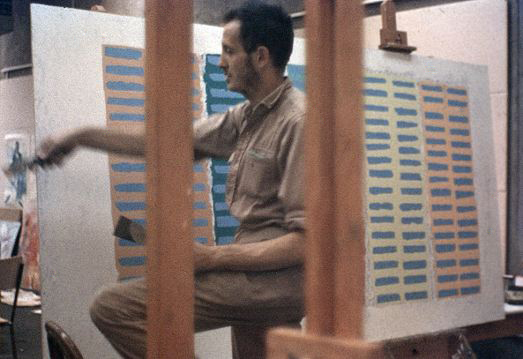
Painting at Emma Lake
These positions were perhaps not as clear in Bloore's mind in 1958 as they were to be ten or fifteen years later. It is true they were drawn from and consistent with his earliest acquaintance with art making and art historical studies, but they became clearer only in the testing ground of contemporary events and expanded experience of world art. Two developments had a profound impact on Bloore's thinking, not in the sense of changing the direction of his thought, but in the sense of deepening and clarifying it. These were the influence of New York art theory on Saskatchewan painting and extensive travel in the Near East.
Bloore had none of the anti-Americanism which was to characterize the attitudes of many later Canadian regionalists at the end of the 1960s. He has always seen the art done in the northern part of the North American continent as part of a variegated visual response to the experience of the society and regions of the continent. The blowing of nationalistic trumpets, for Bloore, is merely done to cover up the basic involvement of Canadian artists in the North American experience. "...[T]he only really fruitful way for us to approach the study of art in Canada is to cease seeing it in terms of this country alone. Rather we should look at it as part of the North American experience..."(33) It is important to establish this position, before looking at Bloore's largely lone battle with the ideas and influence of Clement Greenberg and New York artists whose work Greenberg upheld as the most advanced and dynamic in the art world of that time. The story of the Emma Lake Workshops and the long involvement of some of the artists of the Prairies with the style and ideas of New York art has been recently told in, at least, some of its detail.(34) The exhibition, The Flat Side of the Landscape, organized by the Mendel Art Gallery in Saskatoon, and its extensive catalogue have done much to provide a context for the far reaching impact of the workshops on Canadian and, particularly, western Canadian art. The workshops emanated from Regina College and from their first session in 1955, they had a strong connection with New York. The first workshop leader was Jack Shadbolt, fresh from studying in New York under Hans Hoffman and enthusiastic about the ideas and approaches sweeping through some of the studios, galleries and magazines of the city. He was followed by a fellow Canadian, Joe Plaskett, but after that the workshop was continuously led by New Yorkers for the next decade.
Bloore's introduction to the workshops was in the summer of 1959 when the leader was Barnett Newman. In Newman, Bloore found a sympathetic artist. They shared many interests, both intellectual and artistic, and became friends. It is possible to see even in the work of the two artists a similarity in handling of pictorial space and, perhaps, even image; certainly, they saw eye-to-eye on the non-hierarchical treatment of image and the emphasis on content and meaning. But, basically, I see their areas of agreement more in the broader concerns for the relevance of the art of other cultures and the high seriousness of art making itself. There are many rather horrendous stories of Newman's exercise of the concept of the studio as sacred, including his wife's waiting out in the rain rather than invade the sacred precincts. But, Bloore, too, sees the making of art as a high calling. He has told a story which illustrates their concurrence: While he and Barnett Newman were attending a party in New York, Newman turned to him at one point and said, "Let's leave. Marcel [Duchamp] has arrived and he doesn't take art seriously."(35) Ken Lochhead feels that Newman was probably the only one of the New York artists that Bloore took seriously.(36)
Where Bloore and Newman would have differed would have been on the role of the unconscious as a source of images and content for a painter. Bloore was to say: "The artist does not throw up intentional challenges from his unconscious world to our conscious realm: he offers observations, insight, commentary and his resource is the world."(37)
The May Show of 1960, and its somewhat abbreviated form shown at the National Gallery in 1961, may be seen as a high point for Bloore. The work of his fellow painters, their involvement in the province, the sheer intensity of production, the positive developments of working with New York artists who shared some of their concerns and respected their work and, of course, his own success, not only as a painter, but as an effective gallery director were all heady developments. The exhibition at the National Gallery proclaimed nationally that the Regina Five was a group to be reckoned with. The art writers and pundits began to direct their steps toward Regina.
But in retrospect, some of Bloore's future troubles can be detected in their infancy during these years. His own work was moving in several directions without a central theme. In this first period he painted the great "sunbursts," but he was also experimenting with colour. Much of the work of these years he destroyed in 1963 after returning from a sabbatical year in Greece and the Near East.
↑ ↓ ↑ ↓
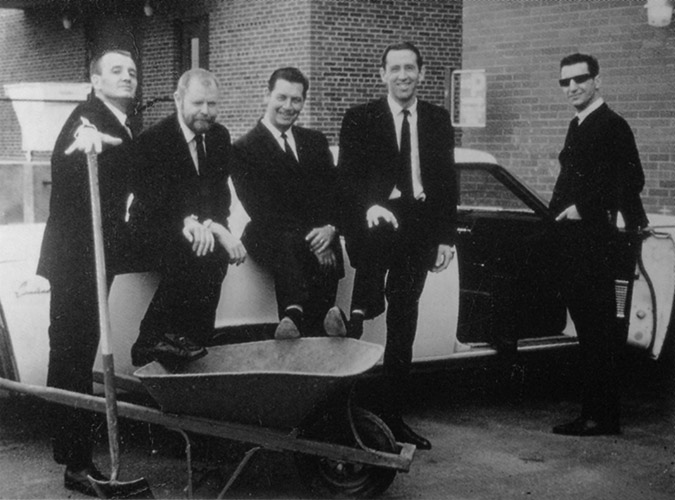 |
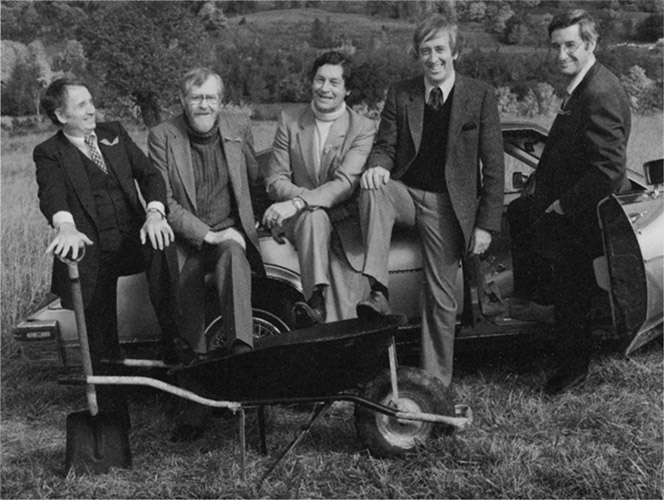 |
His fellow painters, Lochhead and McKay, were experimenting and moving into areas that Bloore felt uneasy about. It was at this time that he had a seemingly silly row with McKay over McKay "stealing" his images. McKay began painting his mandala works and Bloore saw in them his own circles. I suspect that Bloore reacted to what he saw as a decorative use of the image by McKay rather than the sort of iconic treatment that he saw as central to painting. Much later, Bloore would still remember the situation in emotional language: "...I got mad later on when McKay started to steal my images. Then I blew my stack. When he started to steal the circles - then I had to quit making the circles."(38) Perhaps, even the fact that his work did not sell in the West challenged his concept of himself as a painter in and for the region.
But these signs of unrest were merely undercurrents to largely successful years of work. In 1962, Bloore was granted a year's leave of absence and with the assistance of a Canada Council grant, he went to Greece for the year. 1962 was the same year Clement Greenberg was invited by Ken Lochhead to head up the Emma Lake Workshop. He was the first art critic to be invited. Bloore left before he arrived. The visit of Greenberg and the year in Greece and the Near East dramatically changed Bloore's role in the art making of Regina.
Until Ron Bloore went to Greece his experience of the art of other cultures had been largely in museums. The works of European art which he had studied while at the Courtauld Institute had been more or less in situ in their royal buildings. But in Greece, and even more so in Egypt, he saw the works of art in their place, where they had been designed to be. He was confronted in these works with great cultures which stood entirely outside of the naturalist traditions of ancient Greece - Byzantine, Assyrian, Egyptian. Here were powerful images, simplified, sophisticated, of extraordinary quality in construction - enduring. Here was the work of artists who had created images which expressed their culture, land and society for their society. Beside 2500 years of Egyptian work, the art of European painters over the last 500 years seemed much more circumspect and less impressive. Here were examples of art in which the artists had evolved that powerful visual language Kandinsky dreamed of for Europe. The art he saw in the Near East was not preliminary to the development of Greek naturalism as the linear art history of some textbook suggested. Here were images as powerful and modern today as 3000 years ago. Indeed, in the larger scope of world art making, naturalism and its attendant illusionistic representation seemed to be aberrations. Whatever had been accomplished in that tradition was almost momentary compared to what had been created on the planet.(39)
It is not too much to describe this year in the Near East as a revelation for Bloore. He didn't return with sketches of new landscapes or a new understanding of Mediterranean light or renewed energy. He came back shaken and with a new resolve for his own painting. Dorothy Cameron remembers his coming into her gallery shortly after his return and looking haggard and distraught: "His eyes were hollow, just staring." When she pressed him for an exhibition, he finally admitted he had destroyed all his work after having seen the accomplishments of the Near Eastern artists.(40) The region and its art continued to make its overwhelming impression on him. A decade later when he returned, he recalls his experience of going early one morning into a small mosque near the Iranian city of Esfahan: "I've been in the heart of God."(41)
On his return to Regina in 1963, he felt he needed to make a new beginning - to return to "ground zero". From this decision dates his continuous production of white-on-white paintings. Slowly at first, but with a newfound freedom, he turned to much stronger image-making, investigating recurring patterns and iconic forms and boldly integrating image and ground in an array of subtle, but powerful paintings.
The cultural revelation in the Near East and the subsequent new impetus in his painting were the positive side of the year 1962-63. The negative side awaited him in the goings-on in Regina while he had been away. In his absence, Regina had been swept up in a sort of Greenberg mania. As Ken Lochhead was to say, "when we said, 'Clem said...,' it was like saying, 'Jesus said...'."(42) The New York critic's name was on everyone's lips, stories of the summer circulated with relentless insistence, and the enthusiasts felt they were launched on an exciting and new path.
Even the Norman Mackenzie Art Gallery had been enlisted in the Greenbergian cause. Bloore's replacement, Gerald Finley, had worked closely with Greenberg in scheduling a series of exhibitions which would bring to Regina the newest and best of what he called Post Painterly Abstraction. Bloore was furious. He cancelled the exhibitions and declined offers of paintings that could be purchased at below market value. He swept aside the advice coming from New York. His rejection was so extreme and so complete, Greenberg confided to Ken Lochhead: "I'm not in the least angry about it or with him, but I do have the impression he's rather sick."(43)
There could be no doubt, however, that there was a major rift. Bloore and Lochhead preserved their friendship, but the Regina Five was finished, and, what was more important for Bloore, painters he had thought would establish a new frontier in Canadian painting were following or being influenced by what he felt were the totally misguided and ultimately superficial teachings of a non-painter.
Bloore had no more patience with Greenberg's aesthetics of materiality than Barnett Newman had. He saw the entire thought as simply wrong and wrongheaded. He had thought even at graduate school that he saw an inverse relationship between the quality of art and the quantity of art theory; now, he saw the firsthand evidence.
Publicly, he defended his rejection of the Greenberg exhibition schedule on the grounds of its total lack of diversity. "I thought this [is an] academic institution... and I have responsibility to offer people a multiplicity of choices. Not straight down the bloody line."(44) Privately, he mourned the loss of what he had thought was going to be a major development in Regina of strong art making. "The Artists' Workshop at Emma Lake helped to evoke an intellectual atmosphere for an essentially indigenous creative movement in Regina in the late fifties; later workshops have poisoned the integrity of that atmosphere. The workshops at Emma Lake grew, achieved maturity, faltered and finally substituted for creative exploration an imported, critically secure painting theory. It is probable that recent workshops have inhibited rather than stimulated the rich potential in the visual arts on the prairies."(45) He turned away from the workshops and concentrated on painting and running the gallery.
Although his reputation as an artist was now well established, he saw the world in an entirely different light. The Regina Five had never been a group or a movement; now, he had to move more resolutely forward on his own. He handed in his resignation on June 30, 1966,(46) but his departure was really decided by the events of 1962-63. Both his own new directions and the failure in his eyes of the attempt to build a vibrant group of artists in Regina determined his decision. Lochhead had already left for the University of Manitoba in 1964. Lochhead's brother was Librarian at York University and it was via this connection that Bloore was offered a job at the university teaching art history. Although for many artists in Saskatchewan it seemed like the beginning of a new era, for Bloore it was the beginning of a much lonelier path. He left behind his curatorial involvement with artists as colleagues and turned to teaching and working with younger aspirants.